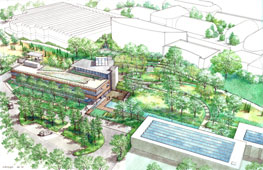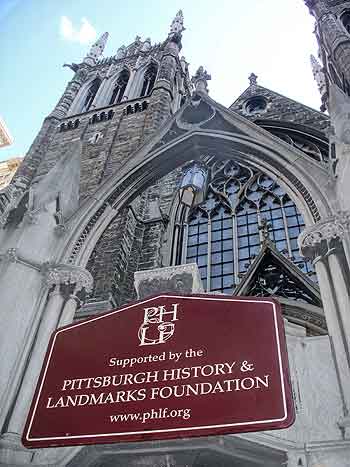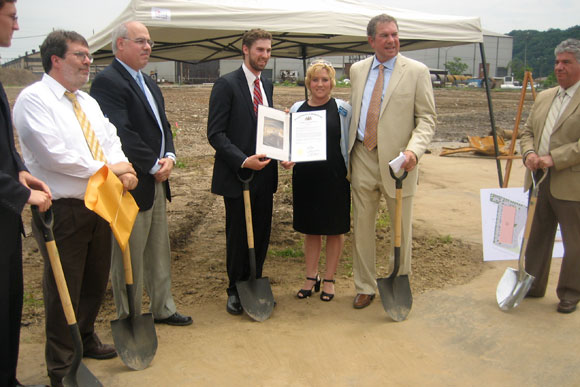
Author Archives: ryochum
-
Garden Theatre Plans in Works
By Sam Spatter, FOR THE PITTSBURGH TRIBUNE-REVIEW
Thursday, June 17, 2010Five developers — three from out of town — are scheduled to present plans for redevelopment of the Garden Theatre block in the North Side to residents at a community meeting next month.
“This will give the developers an opportunity to explain their plans and for the residents to offer their comments,” said Mark T. Fatia, executive director, Northside Leadership Conference, which received the proposals this week.
The developers are considering a mix of residential and first-floor commercial, Fatla said.
The two local developers are Barron Commercial Real Estate of Pittsburgh and Aaron Stubna of Coraopolis.
The out-of-town developers are Resaca LLC of Bethesda, Md., Wells and Co., Spokane, Wash.; and Zukin Development Corp., of Philadelphia.
Fatla said developer Bill Barron has been active along Butler Street in Lawrenceville, and has started work along Federal Street on the North Side. Stubna is only interested in the Garden Theatre, which he would use for films and art projects.
Resaca, an apartment developer, is interested primarily in the Bradberry Building, a former department store.
Zukin, who recently purchased the drug store at Forbes and Murray in Squirrel Hill, is interested in historic preservation, a similar concept from Wells, which was attracted to Pittsburgh by Mike Edwards, president of the Pittsburgh Downtown Partnership, who formerly served in that capacity in Spokane.
“It will be up to the residents and the conference board to select a developer or developers, since some proposals do not include all of the properties within the block,” Fatla said. That could occur by the end of summer.
The block is bounded by Federal Street on the east, W. North on the south, Reddour Street on the west and Eloise Street, on the north. A previous failed development attempt by Jim Aiello Jr. involved only the Federal Street site, which was 30 percent of the total block project, Fatla said.
-
North Park Lake Workers Dig in Deep
By Bill Vidonic
PITTSBURGH TRIBUNE-REVIEW
Thursday, June 17, 2010For nearly 80 years, North Park Lake was considered the centerpiece of the Allegheny County park, its serene waters welcoming boaters and anglers.
These days, it’s anything but welcoming, essentially little more than a muddy hole as it undergoes a $16 million transformation.
Within a year, if all goes according to plan, the lake will be deeper, bigger and once again host nature lovers from across the region.
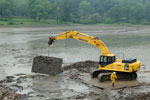
Allison Park Contractors, Inc. work to position swamp pads for installing temporary check dams to slow water in North Park Lake. Once considered the centerpiece of the Allegheny County park, North Park Lake is undergoing a $16 million transformation to reclaim its banks and restore its depth. Jasmine Goldband | Tribune-Review
“We had some little setbacks in the winter, but we’re making some good progress now,” said Craig Carney, project manager for the U.S. Army Corps of Engineers. “We’re still shooting for (finishing) next spring.”
Within the next couple of weeks, workers will begin scooping sediment off the lake bed and into dump trucks. Those trucks will be making 80 to 100 trips a day, Carney said, to an old fly ash dump along Wildwood Road, near the Pie Traynor baseball field.
Carney said motorists, joggers and bicyclists should be aware that the trucks will be in the park.
In all, the corps expects to remove more than 315,000 cubic yards of sediment from the lake.
Stormwater runoff has been dumping sediment into the lake for decades, according to the corps, along with stream bank erosion from portions of Pine Creek and North Fork creek. That shrunk the 75-acre lake to about 60 acres, and cut the depth of the water by more than half in many areas. Some areas of the lake turned into wetlands, and those areas will be protected.
Without the restoration work, Carney said, the lake — albeit in several decades — would degrade entirely into wetlands.
Work to divert North Fork from the upper portion of the lake was completed last week. Pine Creek’s diversion, on the lower portion of the lake, is continuing.
Carney said draining the lake didn’t go as smoothly as first hoped. The lake was drained in September and October, but heavy rains hit in November. Debris that collected at the lake’s gatehouse caused problems in draining the additional water, and that wasn’t fixed until March.
Since then, Carney said, drainage has gone relatively smoothly. Since the beginning of June, nearly 4 inches of rain has fallen. After each storm, workers are able to drain the water within a day or so.
“It’s been a typical spring,” Carney said. “We had a pretty dry late April and early May.”
North Park Lake project: What’s it all about?History: The once-75-acre lake was created in the 1920s. It is located in Hampton, McCandless and Pine.
Project: Sediment had filled the lake, decreasing the lake’s depth and causing problems for boaters and anglers. The lake was drained beginning Sept. 8. Workers will remove at least 315,000 cubic yards of sediment. Once done, the lake will be restored to its original depth of up to 24 feet. North Fork and Pine Creek are being diverted on the northern and southern ends of the lake to drain the lake and allow workers to scoop up the sediment.
Other work: Improvements will be made to help mitigate downstream flooding. Coir logs, composed of coconut fiber, will be laid along the shoreline to prevent further erosion and sediment buildup. Invasive plants are being removed from the lakebed, which will be lined with gravel to encourage fish spawning. In October, 75 percent of North Park Lake fish, including blue gill, crappie, bass, sunfish and catfish, were relocated upstream to Marshall Lake and Deer Lakes Park.
Cost: $16 million. The federal government has contributed $5 million, and the state $400,000. Allegheny County is paying the remainder.
Source: U.S. Army Corps of Engineers
-
Sewickley Tour Offers Glimpse at Early 1900s Garden
By Joanne Braun
SEWICKLEY HERALD
Thursday, June 17, 2010When Janice and Ronald West moved into their Sewickley Heights home 15 years ago, remnants of the past scattered the property.
One such remnant is an old cherub statue perched in the middle of The Gardens of Poplar Hill on the Country Club Road property. It will be included in the Sewickley Civic Garden Council’s garden tour Friday.
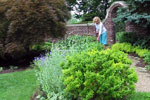
Sewickley Civic Garden Council's garden tour on Friday includes five private gardens within a few blocks of the Edgeworth Club, and a sixth, The Gardens of Poplar Hill in Sewickley Heights, adjacent to Allegheny Country Club. Carolyn Smith, garden tour event coordinator, checks out a few specimens at the Poplar Hill gardens. Joanne Braun | Sewickley Herald
The cherub, which sits in the lower garden, is surrounded by plants, shrubs, brick walls, black iron gates and a roofed summer house, all dating back to the early 1900s. The garden is being cataloged as a historic garden for the Smithsonian Institution in Washington. Village Garden Club’s Garden History and Design committee provided research and documentation — the first time the club, which is a member of the Garden Club of America, has attempted such an undertaking.
Committee members Cathy Snyder, Cordelia Jacobs, Alisa Lenhardt and Lisa Burrows will send their work to the club’s Garden Club of America’s zone coordinator in Philadelphia. Once the research and photos are approved, it will be sent to the Smithsonian for inclusion in the Archives of American Gardens.
Kelly Crawford, museum specialist at the Smithsonian, said the Archives of American Gardens collection captures more than 6,500 American gardens in 80,000 images, historic records, illustrations and plans.
“Some of these records fix a moment in the life of an existing garden, and others describe gardens that are no longer in existence,” she said.
Snyder said Arthur Shurcliff, a member of an architectural firm that became famous for its garden designs, designed the original landscaping at Poplar Hill in 1914.
The property once featured a 35-room carriage house, which later was torn down by a new owner. The property housed numerous families over the years who added structures, sold off some of the land and subdivided it.
In 1948, The Gardens of Poplar Hill were chosen as featured gardens at the Garden Club of America annual meeting. It was part of a tour sponsored by Pittsburgh History and Landmarks Foundation in 1997.
When the Wests moved in, they refurbished much of the deteriorating brickwork, rehung the iron gates, reconstructed and refurbished the limestone windows within the brickwork, and replaced the roof and copper gutters on the summer house.
At that time, most of the flower beds were empty. Poplar trees, for which the property was named, once grew outside the brick walls but were lost to disease in the 1960s.
“There were very little perennials left. We had to start over with the plantings,” Janice West said.
However, large specimen trees, bushes and hedges still flourished throughout the property, and peonies and Japanese iris remained in the lower garden.
As visitors enter the lower garden, they can walk on pathways of blue slate and pea gravel that wind around the inside courtyard. Niches with two Japanese statues, with shallow pools in front of each, face one another across the courtyard.
Also featured are blue spruce and juniper surrounding the side of the house. Dark green boxwood blends with the softer pastel hues of Russian sage and astilbe. Not far away are colored foxgloves and coneflowers mixing with japonica and peonies. Blue geraniums and Japanese grass also make a home in the garden.
“I try to repeat some of the same plants in different spots,” West said.
The couple purchased and placed stone urns to replicate those in photographs from the 1930s atop two brick pillars closer to the house.
Nearby are more large shrubs, which were not there in the original landscape.
“There used to be lillies and flowers along the way. This was just a walkway to the house. I thought about taking the bushes out, but they are so mature,” West said.
As visitors continue to the back of the house, they will get a view of the Allegheny Country Club’s fairways and clubhouse.
That side of the house features an added greenhouse and a large birdbath along with a horseshoe hedge of yews believed to be part of the original landscape. The Wests added more mature yews to the hedges to complete the horseshoe shape, which now surrounds the original English wellhead and two large swamp cypresses. Janice West planted a vegetable garden on the eastern side of the house in the rear, near to where other such gardens originally grew. Plants are held up by trellises of different colors.
In a document prepared for the Smithsonian, committee members wrote, “Without question, Poplar Hill remains a significant treasure in garden design. The fact that it is in the hands of genuine enthusiasts who understand and appreciate the importance of documenting its evolution, preserving its integrity and sharing its beauty with others bodes well for the future.”
If you go
What: Sewickley Civic Garden Council’s garden tour, including five private gardens within a few blocks of the Edgeworth Club. The sixth, The Gardens of Poplar Hill in Sewickley Heights, is adjacent to Allegheny Country Club.
When: 9 a.m. to 4 p.m. Friday. Jan Godshalk, award-winning floral designer, will present a floral arranging demonstration at a luncheon at the Edgeworth Club from noon to 1:30 p.m.
Cost: $20, or $35 for the demonstration. Lunch not included. A combination ticket for the tour and lecture is $50. Tickets are available in Sewickley at Cuttings, Walnut Street; The Gift Corner, Broad Street; and Penguin Book Store, Spoiled Chics and Cheers, Beaver Street.
For more information: Visit www.sewickleygardens.org.
-
Foundations Aid Pittsburgh YWCA’s Green Roof
By Bill Zlatos
PITTSBURGH TRIBUNE-REVIEW
Thursday, June 17, 2010The YWCA is getting a green roof, part of a campaign by charitable foundations to make Downtown more environmentally friendly.
“We’ve seen an increasing number of green roofs in Pittsburgh in the past three years, some of which are Downtown,” said Aurora Sharrard, director of innovation for the Pittsburgh Green Building Alliance.
When its roof is completed, the YWCA will join the Highmark Building, Fifth Avenue Place and the Heinz 57 Center among Downtown buildings with green roofs, she said. The Allegheny County Office Building also is installing one.
Green roofs use plants to soak up rain and reduce runoff, cut heating and air conditioning costs, make the building quieter and improve air quality.
Reducing runoff is especially important in Allegheny County because storm and sewage overflow is released into the rivers during hard rains.
“We want an environmentally responsible green roof,” said Carmelle Nickens Phillips, the YWCA’s vice president of development and communications. “It provides a lot of benefits — a longer material lifespan, energy savings, sound insulation, and it’s really compatible with the neighborhood.”
Phillips cited neighboring Point Park University’s $244 million Academic Village. The university’s plan includes street improvements and tree plantings on Boulevard of the Allies at the end of July and converting the old YMCA building on the boulevard into a Student and Convocation Center. The university completed a dance studio that has a gold certification in Leadership in Energy and Environmental Design, or LEED, from the U.S. Green Building Council.
“We’re very excited about continuing our part of neighborhood enhancements that are green-based and are pleased to know that other neighbors are doing so as well,” said Point Park spokeswoman Mary Ellen Solomon.
The cost of the YWCA roof is $1.1 million. Its building on Wood Street is 42 years old.
The Richard King Mellon Foundation gave the YWCA $125,000 and the Eden Hall Foundation gave $50,000 — raising the total amount from foundations to nearly $400,000. The Mellon Foundation agreed to provide a challenge grant within the next 18 months, and the Pennsylvania Redevelopment Assistance Capital Program will provide $500,000.
Scott Izzo, director of the Mellon Foundation, declined comment. Officials with Eden Hall could not be reached.
-
Study Offers 6 Options for Mellon Arena
By Jeremy Boren
PITTSBURGH TRIBUNE-REVIEW
Thursday, June 17, 2010Demolishing Mellon Arena would make way for a mix of new homes and high-end office space covering nine city blocks in the lower Hill District, according to a study released Wednesday.
The 107-page report provides the first detailed look at six scenarios, which include restoring the arena to its original 1961 design; mothballing it indefinitely; preserving its unique silver dome; and razing it to build 1,191 residential units and 608,000 square feet of offices.
Representatives of the city-county Sports & Exhibition Authority said last week that they favor demolishing the Igloo and allowing the Penguins to build a mixed-use development — a plan referred to as “Option 5” in the study, prepared by consultant Michael Baker Engineering of Moon.
The firm organized seven meetings and a tour of Mellon Arena for public input. The lengthy report is the result and is open to public comment and revision.
The SEA, which owns Mellon Arena, will consider comments on the report before the authority’s board of directors makes a decision on the arena’s fate, said Chris Cieslak, a consultant working with Oxford Development and the SEA.
“What we don’t want is what has happened in Portland, Oregon, where they have talked about it for nine years and the city of Portland has had to pay the holding costs on (Memorial) Coliseum,” Cieslak said. Groups have opposed razing the Pacific Northwest arena.
Penguins President David Morehouse said the team agrees with the report’s findings, which correspond to a market analysis performed by Penguins consultant AECOM.
He wants demolition of Mellon Arena to begin in a year. The team owns the rights to develop the site.
“The last thing we want to do is put an impediment in front of a developer and say: ‘We want you to put this development in but, by the way, you have to put it underneath this dome,'” Morehouse said. “The people proposing that have no developers and no money for that.”
Those trying to save the arena from destruction are surprised by the study’s release. Architect Rob Pfaffman, founder of the Reuse the Igloo group, said he wasn’t aware the full report was available until told by a reporter.
Pfaffman’s vision is to build a boutique hotel inside the arena with retail and open-air park space.
“They have gone on the record, at least with us, that they prefer Option 5,” Pfaffman said. “We don’t think the process was properly followed.”
Pfaffman’s preservation group hired its own consultant to examine alternatives to tearing down the 49-year-old arena — the National Hockey League’s oldest venue. Mellon Arena will be replaced by the $321 million Consol Energy Center when it opens in August across Centre Avenue.
Pfaffman said if the SEA was sincere about finding alternatives to demolishing Mellon Arena, the authority would conduct a more detailed study and perform an engineering analysis of the building.
Neither has occurred.
The study said that in addition to making room for office space and homes, demolishing the arena would allow three north-south streets to be built. The streets would connect Bedford and Centre avenues — roads that planners eliminated when building the arena.
Razing the arena also would provide space for 208,750 square feet of retail development; a 150-room hotel; 2,145 parking spaces; and 57,560 square feet of “public open space located along pedestrian corridors,” the study said.

-
Phipps’ Center for Sustainable Landscapes Chosen to Test New Green Design Rating System
Pop City Media
Wednesday, June 16, 2010
Phipps Conservatory and Botanical Garden’s Center for Sustainable Landscapes, which is in its final phase of design, has been selected to join 175 other pilot programs to test a revolutionary new rating system for green landscape design called The Sustainable Sites Initiative, or SITES.

SITES is similar to the LEED building rating system, only for landscapes, and is set to become the international standard for eco-friendly landscape practices. The Center for Sustainable Landscapes was asked to join the testing program, because of the new building’s impressive list of sustainable features.
The $20 million Center for Sustainable Landscapes, a research and educational institution, will be a Living Building, going far beyond LEED certification, by generating all of its own energy with renewable resources, and capturing all water on site. It features a green roof, rain gardens, permeable paving, locally harvested and salvaged materials, and a wetland and lagoon system. Landscape practices at the building will include protecting and restoring soil conditions, native plant landscaping and ecosystem restoration, and revolutionary energy efficiency.
“The opportunity to combine cutting edge building technology with the highest standards of sustainable landscape design will allow Phipps to present a complete picture of how important it is to sensitively integrate our buildings into the environment and how important plants are to our lives,” says Phipps’ Director Richard Piacentini.
The pilot phase for SITES is scheduled to run through June 2012, and feedback from The Center for Sustainable Landscapes as it nears the end of its design phase and enters construction, will help SITES finalize their rating system by 2013.
Sign up to receive Pop City each week.
Writer: John Farley
Sources: Liz Fetchin, Communications Director for Phipps Conservatory
Richard Piacentini, Director of Phipps ConservatoryImage courtesy Phipps Conservatory and Botanical Gardens
-
Challenge Grant Deadline June 30: Please Contribute Now
PHLF News
June 16, 2010Six weeks ago, PHLF and two of its members pledged $37,500 for an all-or-nothing challenge grant to jump-start our Historic Religious Properties Program that provides matching grants and technical assistance to architecturally significant historic religious properties in Allegheny County who need to undertake critical building repairs.
The challenge grant is contingent on members and friends matching that amount by June 30. This is a terrific opportunity to do as much as we can to build support for our historic religious properties program. We’ve made good progress so far and encourage you to contribute, if you have not yet done so.
To contribute by credit card, use the Targeted Donation Today option on our home page at www.phlf.org, or call Mary Lu Denny (412-471-5808, ext. 527) to process your gift. Or, mail a check payable to “PHLF” and referenced “HRP” (100 W. Station Square Drive, Suite 450, Pittsburgh, PA 15219).
We thank the many members and friends who have already contributed and encourage those who have not yet done so to contribute in the next 15 days. If we can raise $37,500, then two PHLF members will contribute a $25,000 match and PHLF will contribute a $12,500 match. Those contributions, combined with year-end gifts from 2009, will make it possible for PHLF to offer another round of matching grants and technical assistance so architecturally significant historic religious properties in Allegheny County can restore stained glass, repair leaking roofs, and re-point masonry, among other restoration work.
Remember, PHLF is the only nonprofit organization in Allegheny County that helps historic religious properties restore the significant places serving as centers of worship and providing social and cultural services to many people. Your gift will help us continue this valuable program of financial and technical assistance.
We thank you for doing your part during this challenge grant campaign. In July, we will send you news of the campaign results. Your ongoing support helps us protect the places that make Pittsburgh home.
-
90,000 square foot LEED Building Will Be a Huge Boost to Neville Island’s Revitalization
Pop City Media
Wednesday, June 16, 2010
Ground was broken last Friday at the site of a new $5 million speculative 90,000 square foot flex/ distribution building at 4800 Grand Avenue on Neville Island.
“Neville Island has been waiting to be reborn. I believe strongly in the benefits this area can offer all businesses and its vital role to the economy,” says Chuck Snyder, President of Neville Island Commons, and owner of the property. His son, Josh Snyder, is President of the green minded JLS Land Company, the developers of the site.
Snyder’s company purchased the property in May 2008, which previously housed the corporate offices for Dravo Machining Company, an organization which set up operations on the island during World War I to build 300 ships. The Dravo building sat vacant, however, for the last 15 years. Completion of the new building, which is being constructed with green building techniques targeting LEED certification, is dated for January 2011.
Burns and Scalo Real Estate Services Inc. is the contract representative for JLS, and is set to coordinate and run infrastructure services. Their target tenants for the building include office and light industrial users.
The revitalization of Neville Island is aided greatly by its close proximity to I-79, Pittsburgh International Airport, Route 51, and Route 65. The 90,000 square foot building is the latest project in the redevelopment of the island, following the construction of a new Kings Hometown Grille and 110 suite Fairfield Inn.
In addition to the island’s close location to a number of transportation routes, a Local Economic Revitalization Tax is available, which provides a six year tax exemption to new construction.
Senator Wayne Fontana, who helped break ground for the site, referenced the power of this tax abatement when he said, “Neville Island is a shining example of what can be done through public and private partnerships.”
Sign up to receive Pop City each week.
Writer: John Farley
Sources: Chuck Snyder, President of JLS Land Company
W. Scott Kaplan,Director of Acquisition and Development Services for Burns and Scalo
Senator Wayne FontanaPhotograph Copyright John Farley


